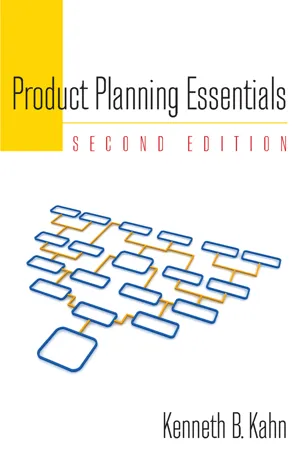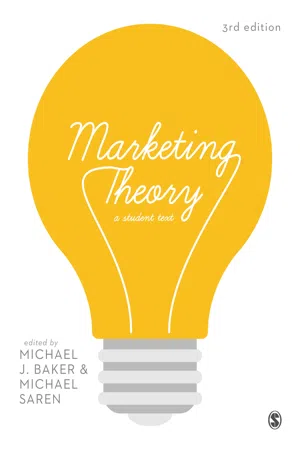Marketing
Product Development Process
The product development process involves the steps taken to bring a new product from concept to market. It typically includes idea generation, market research, design, testing, and commercialization. This process is crucial for companies to create successful products that meet customer needs and achieve business objectives.
Written by Perlego with AI-assistance
Related key terms
4 Key excerpts on "Product Development Process"
- eBook - ePub
- Kenneth B. Kahn(Author)
- 2014(Publication Date)
- Routledge(Publisher)
O’Connor also indicates a variety of challenges to implementing a Product Development Process. These also apply to the ongoing use of an existing Product Development Process:• Process optimization and validation: A preoccupation with achieving an optimal process may be infeasible; a workable process may be just as, if not more, efficient and effective.• Gaining top management commitment and involvement: Without top management support, the process will not be sustained.• Structured decision-making: Clarifying who makes which decisions will avoid confusion and/or conflict.• Developing new product development leaders and high-performance teams: Cross-functional communication and collaboration are necessary to effect product development activities.• Training critical skills and knowledge to support the process.• Portfolio optimization: The company needs to develop a portfolio management process that decides which projects to pursue and which to shelve.• Linking and positioning the process: The Product Development Process must fit with other company processes.Evaluating the Product Development ProcessThere are various ways to evaluate the effectiveness and efficiency of the Product Development Process. One technique is statistical in nature and can be readily applied to assess the risk, cost, and time characteristics inherent in the Product Development Process. Results can indicate the riskiest, costliest, and most time-consuming product development stages.To apply this technique, the risk, cost, and time associated with each product development stage must be determined. Risk should be given in terms of the percent of product concepts that successfully make it through the stage (i.e., successfully pass the respective stage’s gate review). Cost should be given as the standard cost for one product concept to progress through the given stage. Time should be given as the standard time for one product concept to progress through the given stage.Consider the example presented in Exhibit 2.4 - eBook - ePub
Marketing
A Relationship Perspective
- Svend Hollensen, Marc Oliver Opresnik(Authors)
- 2019(Publication Date)
- WSPC (US)(Publisher)
Concept development and testing Any attractive idea must be developed into a product concept. A product concept is a detailed version of the idea stated in meaningful customer terms. Concept testing calls for testing new-product concepts with groups of target consumers. After being exposed to the concept, customers then may be asked to react to it by answering questions such as the following: Do you understand the concept of the product e.g. a fuelcell powered car? Do you believe the claims about the product? What improvements in the product’s features would you suggest? What would be a reasonable price for the product? Who would be involved in your decision to buy such a product?•Marketing strategy developmentThis stage involves designing an initial marketing strategy for introducing the product. The marketing strategy statement consists of three parts: The first part describes the target market; the planned product positioning; and the sales, market share, and profit objectives for the first few years. The second part outlines the product’s planned price, distribution, and budget for the first year. The last part of the marketing strategy statement describes the long-run sales, profit goals, and marketing mix strategy.•Business analysisBusiness analysis involves a review of sales, costs, and profit projections for a new product to find out whether they satisfy the organisation’s objectives. In case they do, the product can move to the product development stage.•Product developmentIn this stage, R&D or engineering develops the product concept into a physical product. This goes along with a large increase in investment. The product development step will show whether the product idea can be turned into a usable product. R&D strives to design a prototype that will satisfy and excite customers. A new product must have the required functional features and also convey the aspired psychological characteristics.•Test marketing - eBook - ePub
- Marilyn A Stone(Author)
- 2007(Publication Date)
- Routledge(Publisher)
The length of this stage varies according to the degree of innovation required and the complexity of the product. The process will be more straightforward if the product uses known technology. For example, a firm launching a new shape of potato crisp will face greater problems in creating a successful brand image and maintaining consistent quality than in developing the production process.This stage requires close co-operation between the different functional areas of the firm. The development experts will be leading the design of the product; manufacturing will be seeking to achieve low-cost production; marketing and distribution will be aiming to achieve the correct marketing mix, sales and logistics. Tests with potential consumers should evaluate functional performance, efficiency, safety and apparent benefit. For consumer goods, pack tests should check ease of use, performance and product image. Research can be conducted to test advertising effectiveness and consumer attitudes towards projected pricing levels.STAGE 6 TEST MARKETING
Consideration of product development and associated test marketing has been referred to in Chapter 5. Their critical role within NPD is reinforced at this point in the text and detailed at pp . This test marketing stage provides information on the likelihood of the target market buying the product, trade response to the product and product performance compared with competition. Such information enables the firm to modify the product where necessary.A standard test market is commonly used for testing FMCGs. It should correspond, as far as possible, to a scaled-down version of an intended national market, in terms of distribution structure, media availability, competitor activity and the target market profile.However, there are a number of disadvantages with test markets. They can take up to three years to complete, at the end of which the firm may lose substantial sums of money if it is unsuccessful. Test markets provide competitors with a chance to study the new product and, perhaps, even to launch a retaliatory product before the new product is launched nationally. For example, prior to its launch in the UK, Carnation Coffee-Mate, a coffee whitener, was test-marketed over a period of six years. This gave a rival firm, Cadbury, ample warning and the opportunity to develop and introduce its own product, Marvel, to compete head-on with Coffee-Mate. - eBook - ePub
Marketing Theory
A Student Text
- Michael J Baker, Michael Saren(Authors)
- 2016(Publication Date)
- SAGE Publications Ltd(Publisher)
The final target segments should not be, at this stage, a major decision for companies who have developed a product with the market in mind and who have executed the various testing stages. Attention should be more focused on identifying the likely early adopters of the product and on focusing communications on them. In industrial markets, early adopters tend to be innovators in their own markets. A recent study by Talke and Snelders (2013) studied the different types of messages and their response in the adoption of new high-tech products. They found that adoption behaviour of consumers is positively affected by the inclusion of information on the personal and social consequences of using the new product, especially when such information is presented by using examples and figurative descriptions. Additionally, they found that when technical and financial information is conveyed using fact-based descriptions and specifications, there is also a positive and strong impact on adoption of the new product. This research and others in the same field underline the importance of using market research throughout the development and evaluation process to ensure that the right information will be presented in the right form to the intended market segment(s). The central concerns of the launch should be the development of a strong, unified message to promote to the market and to ensure that supply and delivery chains are stocked and equipped to fulfil demand and orders. Once accepted by the market, the company will elicit feedback to continue the improvement and redevelopment of the product.A critique of new Product Development Process models
One of the keys to the usefulness of the staged process models is the indication they provide regarding the magnitude of the project required to develop and launch a new product. A study in the UK by Hart, Tagg and Ozdemir (2008) reported ‘variable recognition’ of the different stage gates in the NPD process, more recently Markham and Lee (2013) report that 49.1% of the 383 firms responding to the PDMA comparative performance study claimed to have a formal, cross-functional process for NPD. This contrasts with previous PDMA surveys which showed that in 1994, 69% of firms reported such a process. Despite the decrease in the overall reported usage of such models, Markham and Lee (2013) observed in their study that significantly more of the higher performing product developers (labelled The Best) used cross-functional models, whereas the remainder of the survey respondents (labelled The Rest
Learn about this page
Index pages curate the most relevant extracts from our library of academic textbooks. They’ve been created using an in-house natural language model (NLM), each adding context and meaning to key research topics.



